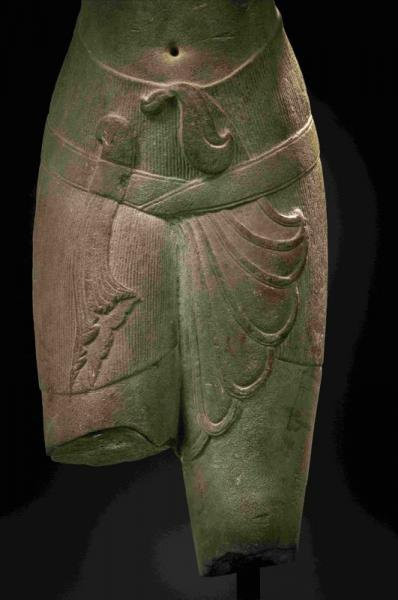A sandstone torso of a male deity, Cambodia, Khleang style, late 10th-early 11th century
Lot 64. A sandstone torso of a male deity, Cambodia, Khleang style, late 10th-early 11th century; 70cm (27 9/16in) high. Estimate 100 000 € - 150 000. Sold for €164,175. photo Fabrice Gousset.
The elegant torso with subtle, yet powerful representation of his pectoral muscles and broad shoulders. The superb sampot is rendered in narrow vertical pleats and spreads across the left thigh in broader fan-like manner. The fabric is drawn between the thighs and arranged on the verso in a double hook that rises from beneath the belt. The observation of the garment by the artist is remarkable in the manner in which it is secured with a delicately depicted overlapping sash on the left side and is pulled under the right side with a fold protruding artfully from the top and the end draped in a scabbard-like fold.
Provenance: Robert Rousset, Paris (1901-1981), acquired from Peng Seng, Bangkok, 26 January 1971
Jean-Pierre Rousset, Paris (1936-2021).
Published, Illustrated and Exhibited: Sherman Lee, Ancient Cambodian Sculpture, Asia House Gallery, New York, October 1969, p.50, no.12.
Note: This rare and very important sculpture represents the transition in aesthetic tastes under Sûryavarman I (1002-1010) that defined the Khleang style. It is most likely that the figure portrays Avalokiteshvara due to the presence of four arms and the ruler's favour of Buddhism. The shoulders are quite straight and do not yet have the roundness of the style of the Baphuon and the adaptation of the sampot closer to the style of Banteay Srei. As with an example in the Norton Simon Museum of Art (P.Pal, Asian Art from the Norton Simon Museum of Art, Volume 3, p.184, no.145) the sampot has become shorter and has an oblique edge stopping at mid-thighs. The rendering of a finely pleated fabric replaces the broad vertical panels favoured in the 10th century reflecting the residual hieratic power of Pre Rup (see Jessup and Zéphir, Sculpture of Angkor and Ancient Cambodia, Millennium of Glory, 1997, p.218, no.46), and predicts the following celebrated Baphuon style (see lot 66). Here the sampot circles the waist in a flatter line as opposed to riding high on the hips as seen in Baphuon but is carved with the same delicacy and lightness (see Brand and Phoeurn, The Age of Angkor: Treasures from the National Museum of Cambodia, Australia, 1992, p. 74).
Cette rare et très importante sculpture traduit la transition des styles sous Sûryavarman I (1002-1010) qui annonce le style de Khleang. La préférence du souverain pour le bouddhisme suggère que cette statue est une représentation d'Avalokiteshvara, avec ses quatre bras. Les épaules sont assez raides et n'ont pas encore la rondeur du style de Baphuon. Le style du sampot est plus proche du style de Banteay Srei. Dans l'exemple du Norton Simon Museum of Art (P.Pal, Asian Art from the Norton Simon Museum of Art, Volume 3, p.184, no.145) le sampot est plus court avec un bord oblique s'arrêtant à mi-cuisse. Le rendu d'un tissu finement plissé remplace les larges pans d'étoffe verticaux privilégiés au Xe siècle, reflétant le pouvoir hiérarchique résiduel de Pré Rup (voir H.I.Jessup et T.Zéphir, Sculpture of Angkor and Ancient Cambodia, Millennium of Glory, 1997, p.218, no.46), et prédit le célèbre style Baphuon qui suivra (voir lot 66). Ici, le sampot entoure la taille d'une ligne plus plate contrairement au style de Baphuon qui est au-dessus des hanches, mais il est sculpté avec la même délicatesse et légèreté (voir Brand et Phoeurn, The Age of Angkor: Treasures from the National Museum of Cambodia, Australia, 1992, p.74).
Bonhams. The Robert and Jean-Pierre Rousset Collection of Asian Art: A Century of Collecting - Part 1. Paris, 25 october 2022.

/https%3A%2F%2Fprofilepics.canalblog.com%2Fprofilepics%2F1%2F0%2F100183.jpg)
/https%3A%2F%2Fstorage.canalblog.com%2F03%2F02%2F119589%2F96711876_o.jpg)
/https%3A%2F%2Fstorage.canalblog.com%2F11%2F31%2F119589%2F94773502_o.jpg)
/https%3A%2F%2Fstorage.canalblog.com%2F20%2F83%2F119589%2F94772815_o.jpg)
/https%3A%2F%2Fstorage.canalblog.com%2F26%2F72%2F119589%2F75604929_o.jpg)
/https%3A%2F%2Fstorage.canalblog.com%2F59%2F60%2F119589%2F26458628_o.jpg)









/http%3A%2F%2Fstorage.canalblog.com%2F80%2F37%2F119589%2F129777139_o.jpg)
/http%3A%2F%2Fstorage.canalblog.com%2F59%2F28%2F119589%2F129531508_o.jpg)
/http%3A%2F%2Fstorage.canalblog.com%2F39%2F44%2F119589%2F122417439_o.jpg)
/http%3A%2F%2Fstorage.canalblog.com%2F24%2F42%2F119589%2F121295195_o.jpg)